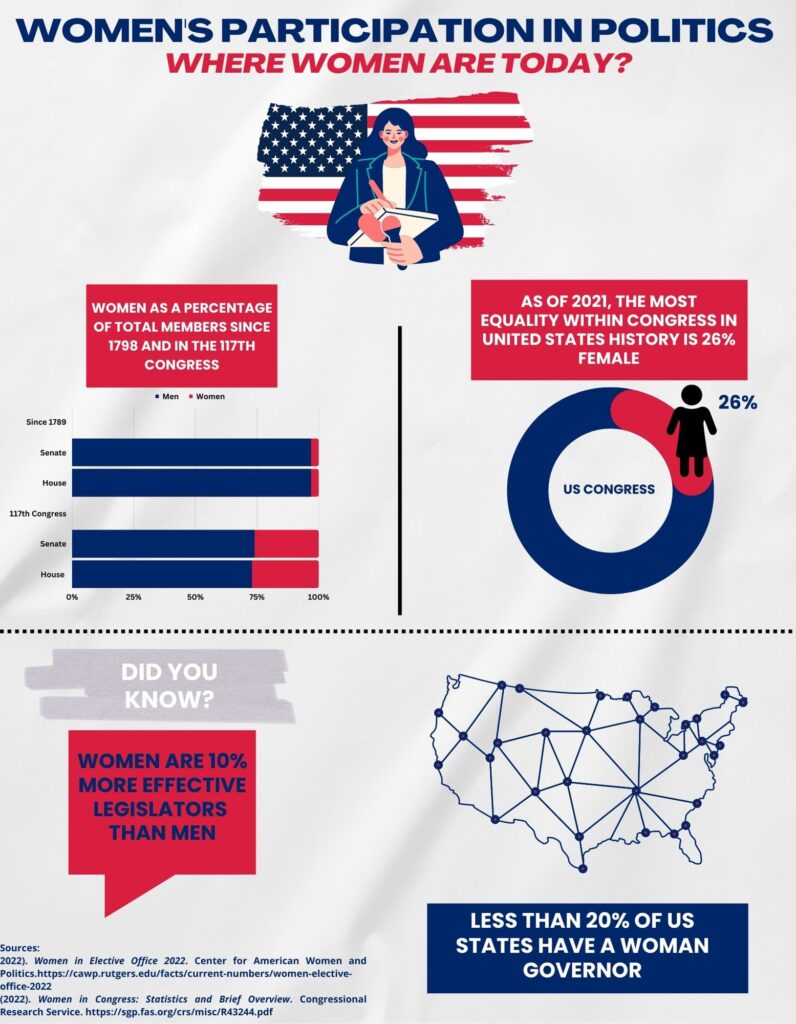By Angela Clark & Alyssa Gazivoda
Throughout our nation’s political history, evidence of women’s political participation has increased and yielded striking results. Even with rising participation, women still remain far from equal and continue to struggle, which is why this needs to change. As of 2022, there were 148 women sworn in at the beginning of the 117th Congress, which surpassed the 130 women that were serving in the 116th Congress (Women in Congress: Statistics and Brief Overview, 2022). In 2021, a record-high for women serving in the U.S. Senate was 26 of 100 seats (Women in Elective Office 2022, 2022). In the same year, 30.6% of 310 seats of statewide elective executive officials were women (Women in Elective Office 2022, 2022). As illustrated in our infographic, the data has shown slight improvements over an astounding 200-year period (Women in Congress: Statistics and Brief Overview, 2022). Due to less female participation in politics, how can political institutions aid in promoting women’s voices being heard when they insert their concerns into political discussions?
A policy intervention that would encourage more participation of female candidates would include creating public campaign funding and support programs that boost female candidates’ fundraising potential (Rothschild, 2020). Changing our electoral rules so that each voice has equal weight will bring us closer to a perfect union (Rothschild, 2020). It would be interesting to see more programs and organizations put in place to inspire political ambition in young women. This could include webinars for them to engage in and workshops about the political system.
The lack of women in politics has troubling consequences and limits our country’s potential. This country is built on the foundation of democracy and everyone’s voices being heard. When women face significant barriers to becoming the face of their communities, the very basis of representative democracy is weakened (Rothschild, 2020). Despite gender-based obstacles, female politicians have been shown to govern in more democratic ways, to be more effective at improving the health of their constituents, and to be more successful and adaptive in pursuit of issue specialization and consensus building (Rothschild, 2020).
On a personal level, this issue has impacted us significantly in regard to experiences from our adolescent years. In grade school, when we learned about politicians, there were only ever lectures or depictions of male representatives. We cannot remember a time when a discussion around a female politician was ever a focal point of the lecture, which served as a norm that we have been accustomed to since.
Additionally, a factor that played a role in deterring us from a career in politics as women is due to the negative media portrayal of female politicians. We have seen women politicians be discriminated against and negatively valued under stereotypes in media coverage, even with less coverage of female politicians overall. After discussing our research and past experiences, we believe that exposing young women to female politicians and how they ended up pursuing a career in politics can bring about change and inspire adolescent females to want to consider pursuing a profession in politics. With that being said, how can institutions do their part to implement change into their curriculum or class structure in efforts to increase exposure to women in politics to help empower and improve confidence for their female students?
Throughout our research, we have learned that although there have been strides to improve female participation in politics, there is still a long way to go. Aside from what the data entails, even in sectors across all careers, women have key contributions to make to leadership and should have a seat at the table. Diverse leadership in politics benefits all, and an upward trajectory of women’s political participation can enhance this notion. Understanding this has shifted our worldview to having optimism in that policy intervention and sustainable implementation can aid in the continued efforts to close the gap.

Sources:
Rothschild, L. E. (2020). “The Gender Gap in American Politics: How Money in Politics Affects Female Representation.” Inquiries Journal, 12(10).
(2022). Women in Congress: Statistics and Brief Overview. Congressional Research Service. https://sgp.fas.org/crs/misc/R43244.pdf.
(2022). Women in Elective Office 2022. Center for American Women and Politics. https://cawp.rutgers.edu/facts/current-numbers/women-elective-office-2022